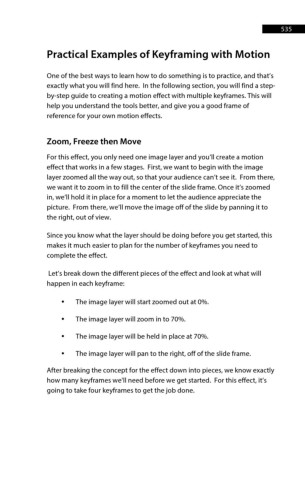Page 536 - ProShow Producer 9 Final Manual
P. 536
535 535
Practical Examples of Keyframing with Motion
One of the best ways to learn how to do something is to practice, and that’s
exactly what you will find here. In the following section, you will find a step-
by-step guide to creating a motion effect with multiple keyframes. This will
help you understand the tools better, and give you a good frame of
reference for your own motion effects.
Zoom, Freeze then Move
For this effect, you only need one image layer and you’ll create a motion
effect that works in a few stages. First, we want to begin with the image
layer zoomed all the way out, so that your audience can’t see it. From there,
we want it to zoom in to fill the center of the slide frame. Once it’s zoomed
in, we’ll hold it in place for a moment to let the audience appreciate the
picture. From there, we’ll move the image off of the slide by panning it to
the right, out of view.
Since you know what the layer should be doing before you get started, this
makes it much easier to plan for the number of keyframes you need to
complete the effect.
Let’s break down the different pieces of the effect and look at what will
happen in each keyframe:
• The image layer will start zoomed out at 0%.
• The image layer will zoom in to 70%.
• The image layer will be held in place at 70%.
• The image layer will pan to the right, off of the slide frame.
After breaking the concept for the effect down into pieces, we know exactly
how many keyframes we’ll need before we get started. For this effect, it’s
going to take four keyframes to get the job done.

